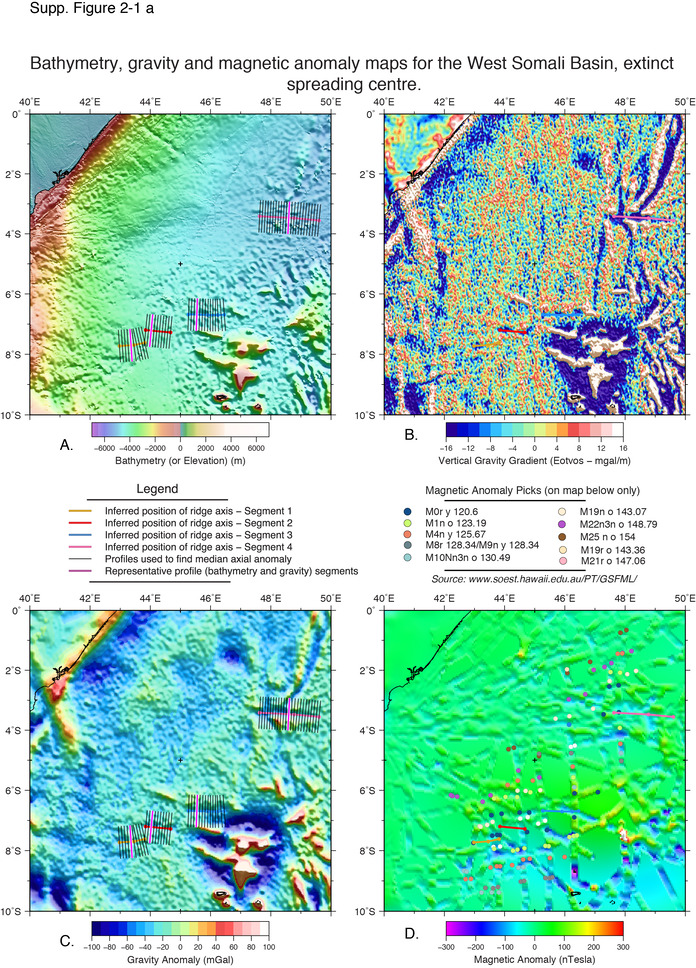| Ocean: | Indian |
| Spreading center type: | Large-scale extinct MOR |
| Time of cessation: | Either M0 (120.6 Ma) (Cochran, 1988) or M10 (ca. 130 Ma) (Rabinowitz et al., 1983) |
| Subsequent active spreading center: | Southwest Indian Ridge (SWIR), south of Madagascar |
| Cessation style: | Abrupt cessation is proposed by Eagles and König (2008) to explain the lack of clear gravity signal at the extinct ridge segments. |
| Later deformation or volcanism | None evident |
Symmetric Mesozoic magnetic anomalies were identified within the Somali Basin in the early 1980s, about an inferred extinct ridge oriented in an east – west direction (reported within Cochran, 1988). Interpretation of magnetic anomalies in the basin has been contentious, with the sequence first interpreted as series M0 to M22 (Segoufin and Patriat (1980), discussed within Cochran, 1988), and later as the sequence M10 to M25 (Rabinowitz et al., 1983). Gaina et al. 2010 offer a further interpretation, suggesting an even earlier initiation of oceanic spreading from as early as M40, which they model to continue until M4 as outlined within a conference abstract and poster but that has not been reported in a peer-reviewed study.
These various interpretations lead to differences of between 12 and 20 m.y. with respect to timing of oceanic spread commencement and cessation and some differences in placement of the inferred extinct spreading center. In addition, some interpretations require a more complex opening of the basin. Small-scale ridge-jumps immediately prior to cessation are proposed by Eagles and König (2008), who follow the Rabinowitz et al. (1983) interpretation of basin oceanic spreading between anomalies M25 and M10.
It is generally accepted that after extinction of the West Somali Basin, spreading commenced to the south of Madagascar and Sri Lanka, representing a large-scale migration of the active spreading center and resulting in transfer of the Madagascar continent to the African Plate. The present-day configuration of the Southwest Indian Ridge (SWIR) may have been established at this time, although it is also possible that there was a further reorganization related to the possible extinct spreading center located between the Conrad and Del Cano Rises (ID 2.4).
The Crozet Hotspot is proposed to have been active from ca. 183 Ma (Courtillot et al., 2003), and the proximal Marion Hotspot may have been active from ~88 Ma (Courtillot et al., 2003). It is possible that the activity of the hotspot to the south of Madagascan was an influence on the spreading migration, as a hotspot influence has been suggested in commencement of spreading in the Mascarene Basin (Bhattacharya and Chaubey, 2001).
Review of the tectonic fabric of the West Somali Basin, using updated satellite gravity data (Sandwell et al., 2014), improved the location of extinct spreading center segments. The extinct ridge axis is segmented, with left lateral offset of segments of less than 100 km between segments except in the case of the most easterly. The latter segment, is situated beyond the Very Large Crude Carrier (VLCC) and Auxilliary Rescue and Salvage (ARS) fracture zones that can be seen in Figure 10 of Cochran (1988). The eastern segment is offset to the north by almost 450 km from the segments to the west. The tectonic fabric east of the Dhow fracture zone at ca. 3.4 ° S, features a V-shaped negative gravity lineament, that is similar to that seen at the Magellan extinct spreading center in the northern Pacific Ocean. This could reflect a fanning opening of the eastern segment.
Although some uncertainty remains regarding the timing of the West Somali Basin ridge extinction, we classify the ridge in the "well-defined" extinct ridges.
Cochran, J. 1988, Somali Basin, Chain Ridge, and origin of the Northern Somali Basin gravity and geoid low, Journal of Geophysical Research: Solid Earth, v. 93, no. B10, p. 11,985 – 12,008.
Courtillot, V., Davaille, A., Besse, J. and Stock, J., 2003, Three distinct types of hotspots in the Earth’s mantle, Earth and Planetary Science Letters, v. 205, no. 3-4, p. 295–308.
Eagles, G. and König, M. 2008, A model of plate kinematics in Gondwana breakup, Geophysical Journal International, v. 173, no. 2, p. 703–717.
Nogi, Y., Nishi, K., Seama, N. and Fukuda, Y., 2004, An Interpretation of the Seafloor Spreading History of the West Enderby Basin between Initial Breakup of Gondwana and Anomaly C34, Marine Geophysical Researches, v. 25, no. 3-4, p.221–231.
Rabinowitz, P.D., Coffin, M.F. and Falvey, D., 1983, The separation of Madagascar and Africa, Science, v. 220, no. 4592, p. 67-69.


